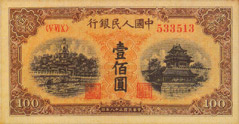 People's Bank of China was established in Shijiazhuang, Hebei on 12/1 1948. The first series of Renminbi (People's Currency) Yuan started to circulate since that day until 5/10 1955. Because the life span of it crossed two historical eras, the first series of RMB has a significant meaning Chinese monetary history. People's Bank of China was established in Shijiazhuang, Hebei on 12/1 1948. The first series of Renminbi (People's Currency) Yuan started to circulate since that day until 5/10 1955. Because the life span of it crossed two historical eras, the first series of RMB has a significant meaning Chinese monetary history.
The first series RMB was based on pre-communist local currencies. The unification was a rough process. The local currencies were products of isolated liberated regions. After victory against Japan, every local governments in the liberated region began their work of currency unification. For example, Huazhung liberated region (region around Yangtze River) issued Huazhung's currency, and collect various local currencies with different values. All other regions employed policies of similar fashion. But before the ultimate completion, the Nationalist-Communist Civil was broke out and the currency unification was forced to suspend.
In the summer of 1947, the war was close to final victory, People's Liberation Army with the help from civilians, won some major battles. As the liberated areas in the north, northwest, and the east start to connect one another, trade began to expand. But the regional currencies did no good but confused people and make trading harder. Therefore it was urgent that the currency must be unified.
On 10/24 1947, the communist central government founded financial office of Huabei (north, around Yellow River, but not Inner Mongolia) and started to unify the currency. Soon after, Bank of Shansi Chahar & Hopei (Shansi = Shanxi, Hopei = Hebei, Chahar is part of today's Inner Mongolia) stopped issuing their banknote, and Bank Chinan(Hebei South) began the sole banknote issuer in Huabei region. In January 1948, the northwest region stopped using notes issued by Shaanganning Bank(short for Shaanxi, Gansu, and Ningxia), with Northwestern Bank of Farmers (Sibei Nung Min Inhang) banknotes as the replacement. In October, Bank of Peihai in Shandong banknotes and Huabei banknotes circulated concurrently. In November, Bank of Peihai banknotes is the only legal tender in Huabei region. At the end of 1948, the unification in Huabei, Northwest, and Huadong (Shandong) is complete, while Huazhong (central) and Northest remain separated monetary regions.
To take it to the next step, the government of Huabei, Shandong, Shaanganning, and Jinxuei decided to merge Bank of Huabei, Bank of Peihai, and Northwestern Bank of Farmers, and formed People's Bank of China (PBC) in Shijiazhuang, Hebei on 12/1 1948. The text of "People's Bank of China" on the first series of RMB is the handwriting of the chairman of Huabei government. The first batch issued was 10 Yuan, 20 Yuan, and 50 Yuan, first circulated in Huabei, Shandong, and Northwest region. Later, 1 Yuan, 5 Yuan, and 100 Yuan, were introduced. Since then all denomination started to spread across the country.
After the issuance of RMB, all regional banknotes ceased to be legal tender and must be exchanged at certain rate. The rate was RMB to Bank of Chinan notes, Bank of Peihai notes, Bank of Huazhung notes, and Zhongzhou Bank of Farmers notes = 1:100, RMB to Bank of Shansi Chahar & Hopei notes, Tung Pei Bank of China (Northeast Bank) notes = 1:1000, RMB to Northwestern Bank of Farmers notes and Shaanganning Bank notes = 1:2000.
In January 1949, Peiping was liberated (and is renamed back to Beijing), and PBC was moved to Beijing. After the founding of People's Republic of China, PBC had branches in all provinces, autonomous regions, and municipals. At the end of 1951, RMB has become the only legal tender in China except Tibet (Xizang), Taiwan, Hong Kong, and Macau (As of now, Taiwan Dollar is the only legal tender in Taiwan. Under "One Country Two System", Hong Kong Dollar and Macau Pataca are the only legal tender in Hong Kong and Macau, respectively). In December 1953, there were 12 denominations and 60 different designs of RMB in total. They are 2 types of 1 Yuan, 4 types of 5 Yuan, 4 types of 10 Yuan, 7 types of 20 Yuan, 6 types of 50 Yuan, 9 types of 100 Yuan, 5 types of 200 Yuan, 6 types of 500 Yuan, 6 types of 1000 Yuan, 5 types of 5000 Yuan, 4 types of 10000 Yuan, and 2 types of 50000 Yuan.
Due to technology limitation and unstable environment, the design of the first series RMB does not show much unity. The image includes industry, agriculture, transportation, and historical sites. They were complicated and without main theme. In order to meet the demand, all printing shop were put to use, regardless of their quality.
On 3/1 1955, the second series RMB dated 1953 was introduced. The first series gradually cease to be legal tender from 4/1 to 5/10.
| |